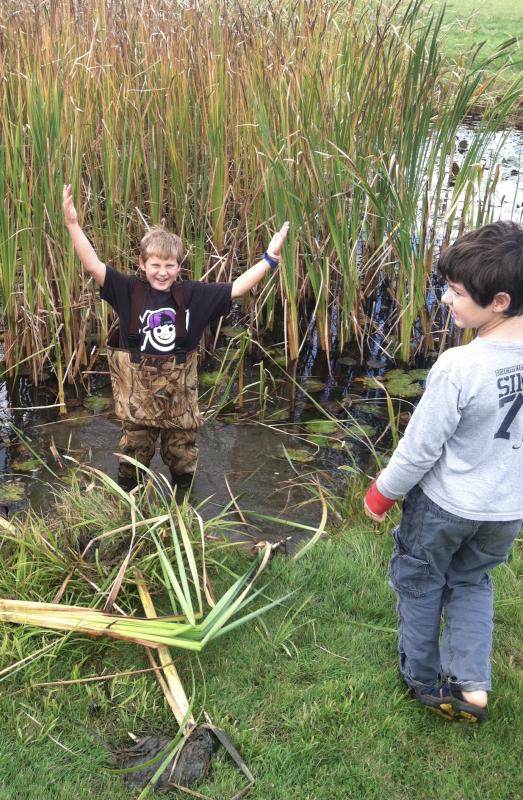Six Stewardship Education Alliance grants awarded to local teachers

What do clams, birdhouses, a rain barrel system, a community garden, a drone kit with GPS camera and binoculars have in common? All will enhance special programs in local schools, and all are made possible through grants from the Stewardship Education Alliance.
Last fall, the EES advisory board suggested that EES-supported projects require data collection. The SEA board agreed that students of all ages can engage in citizen science and learn scientific methods of observation and data collection. SEA President Barbara Lawrence adds that this method of investigation supports SEA’s mission and will contribute to the understanding of local environments. (Please visit SEA’s new website: www.StewardshipEducationAlliance.org).
Grants awarded this year include:
APPLETON VILLAGE SCHOOL: drone kit with DJI Mavic Mini GPS camera
Using a drone kit with GPS camera, middle school students participating in the multi-year Watershed Survey and Mapping Project and the Nature Trail Services Learning Project will add layers of detail and precision data already collected on the local watershed. As 6th, 7th and 8th grade science teacher David Munson notes, “The iPad-compatible programmable device will provide a valuable ‘hook’ for tech-conscious students, allowing them to pursue their own interests in STEM. while providing valuable data to the larger project.
HOPE ELEMENTARY SCHOOL: Birdhouses and Native Plants
The addition of a wildlife garden and birdhouses on the nature trail started in 2021 with support from SEA will promote more biodiversity and provide students with the opportunity to observe an abundance of plants, animals and insects . This increase in environmental activity will allow for a richer data collection experience. Teacher Colin Amundsen, who is dedicated to outdoor education and expeditionary learning, notes that when students are connected to nature, they do better in school and are more fully engaged.
LINCOLNVILLE CENTRAL SCHOOL: Binoculars for the eBird program
The binoculars will primarily be used by students participating in the eBird Community Science Program. Students will spend time outside of school identifying birds and the lists of birds they see will be uploaded to the eBird database. The eBird database is accessible to everyone and is used by scientists around the world. Middle school science teacher Jill Feeney has taken several courses at the Cornell University Lab of Ornithology, and the binoculars will allow her students to engage in meaningful observations and data collection.
PEOPLEPLACE COOPERATIVE PRESCHOOL: A Rain Barrel System
With help from the Knox-Lincoln Country Water & Soil Conservation District and funding from SEA, PeoplePlace will build a rain barrel system that includes a gutter, pipe, barrels, and a pump that brings water to a playground . Director Sessa Salas explains: “Children are naturally curious. When water is available to them as a natural element, they are actively engaged in patterns (patterns or mental processes that we create by trial and error through experiences) such as transformation, trajectory and transport, all of which promote problem-solving, cause-and-effect, and an understanding of the world around them. PeoplePlace may also be able to purchase native plants to manage water flow.
RILEY SCHOOL: equipment to investigate clam predation
Riley School students will study the effects of predator exclusion units and changing abiotic factors on clam (mya arenaria) populations in nearby Clam Cove. Historically, this area had a healthy population of wild clams, but in recent years the population has declined significantly. The Riley School will initiate an investigation to determine if the decline in clams in this creek is due to increased predation, changes in environmental abiotic factors such as increased turbidity, nutrient loading, temperature, pH and dissolved oxygen, or both to predation. and changes in abiotic factors.
Principal Rebecca Clapp explains, “To study this phenomenon, students at Riley School will build experimental predator exclusion units. Students will construct the units, making 25cm x 25cm x 10cm wooden frames, and covering the top and bottom of the units with each predator control treatment (nets). For this study, they will use three predator control treatments: 1) none (controls); 2) flexible net; and 3) rigid netting. The students will place these units in the middle and upper intertidal zones of Clam Cove in late April, corresponding to the clam spawning cycle. Once the units are placed, students will take weekly water samples to test for abiotic parameters, such as temperature, pH, dissolved oxygen, turbidity, nitrate, and phosphate. When students return to school in the fall, they will collect their predator exclusion units and count and measure the clams in each treatment box.
SWEETLAND SCHOOL at SWEETTREE ARTS: Materials to build and plant a community garden
Principal Lindsay Pinchbeck describes the project: “This spring, students will build a community garden and connect with Hope’s Edge Farm. The middle schoolers will work closely with local gardeners and develop a business plan and start a small farm stand to sell greens in the center of Hope. Elementary students will lead a community program to plant sunflowers in honor of tragedies in Ukraine and create interactive gardens using the skills gathered in our carpentry workshop to create beautiful interactive environments. Children will participate in preparing the land, planting, harvesting and selling flowers and greenery in early spring and fall. They will also create their own stand on the farm in the school’s carpentry workshop.
She adds: “Through slow and conscious actions, we can take care of the environment and the world around us. We can reduce the impact on a variety of practices that impact our environment and encourage self-reliant practices and inspired stewardship to care for our lands and our environment.